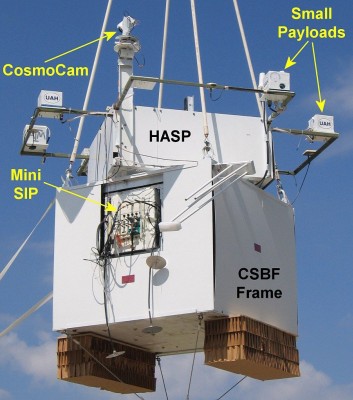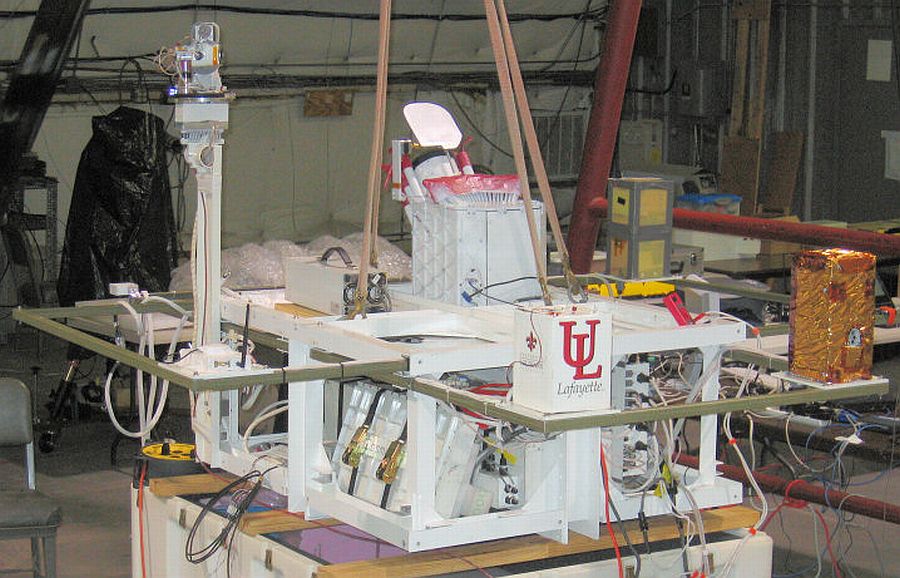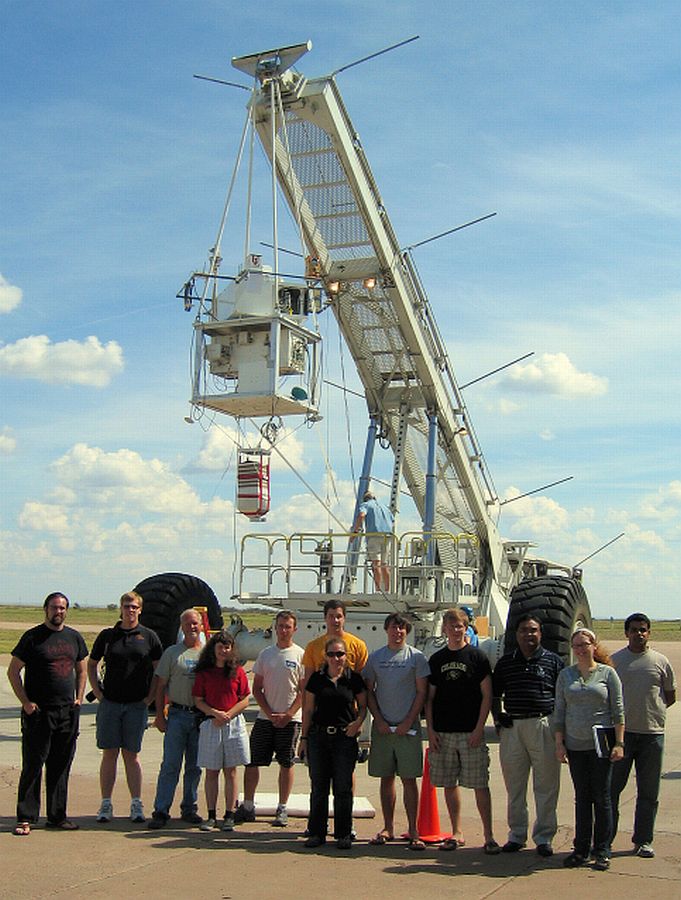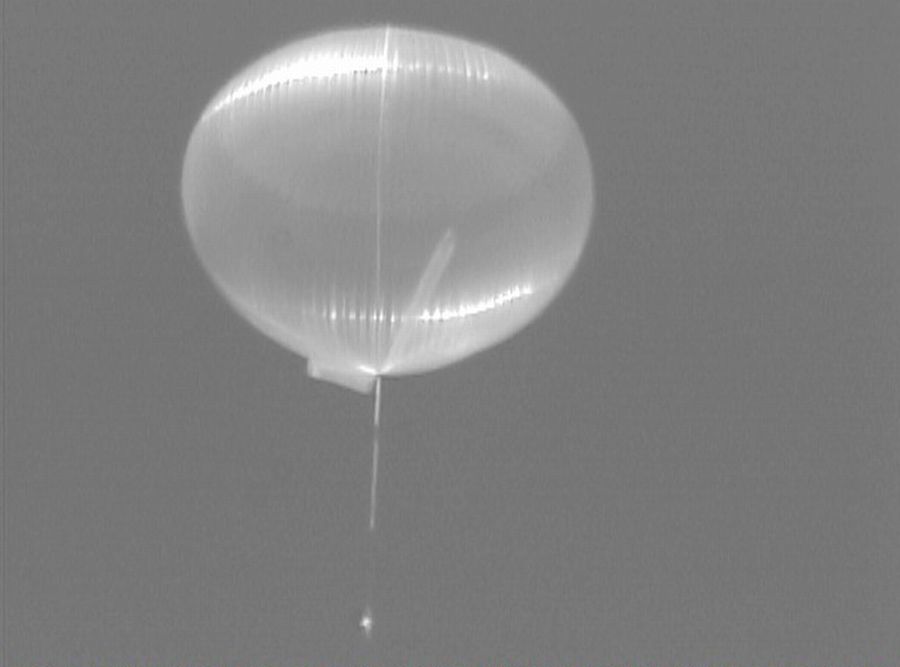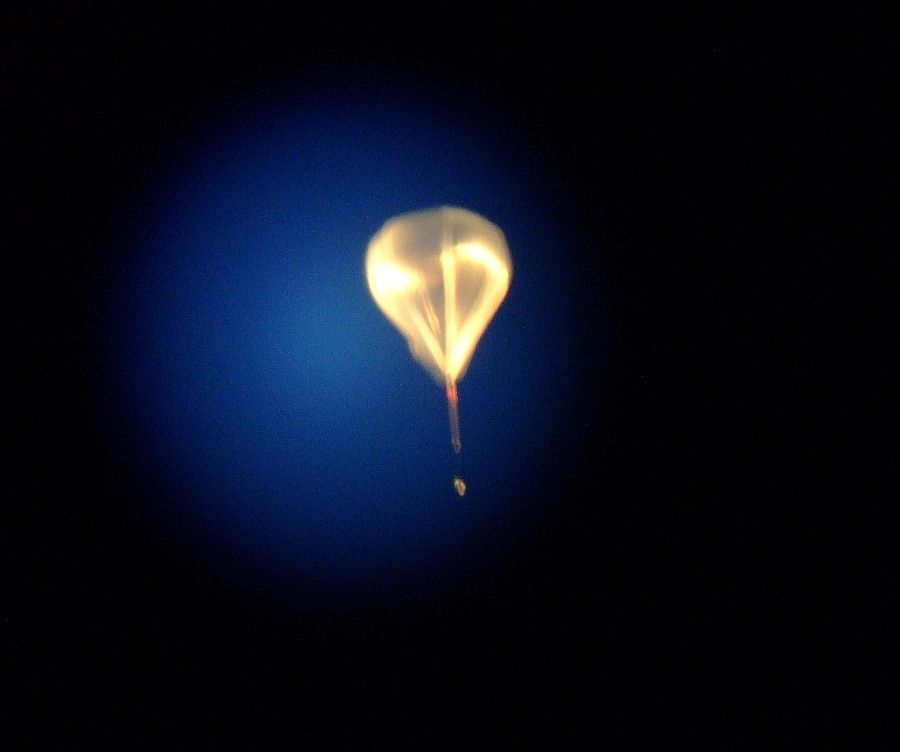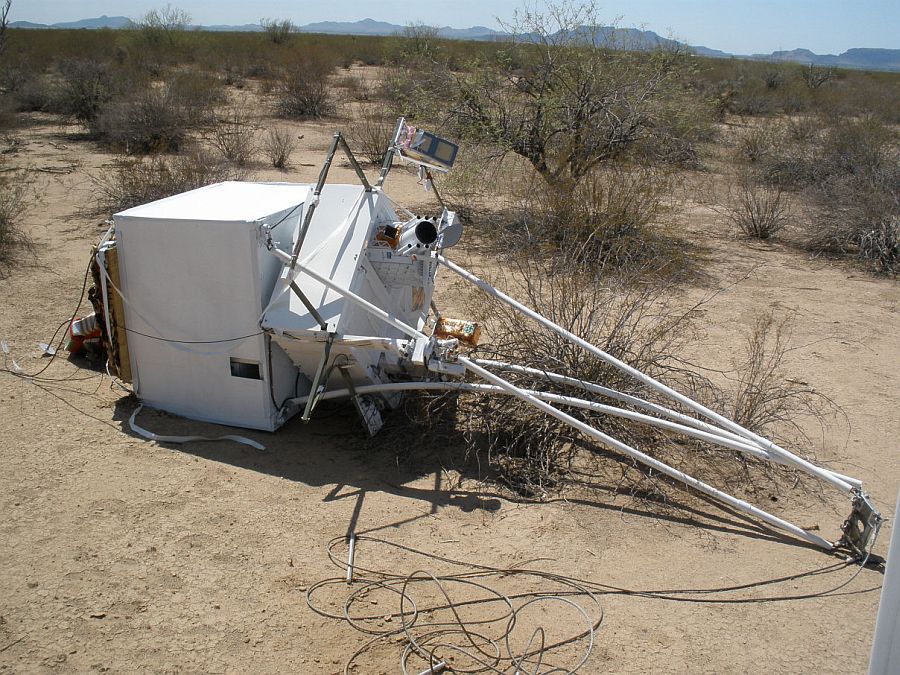Purpose of the flight and payload description
HASP stands for High Altitude Student Platform and is a program aimed to foster student excitement in an aerospace career path and to help address workforce development issues in this area. In the framework of the program a multi-instrumented platform was designed to carry up to twelve student payloads to an altitude of about 36 kilometers with flight durations of 15 to 20 hours using a small volume, zero pressure balloon. The payloads carried by HASP are designed and built by students and are used to flight-test compact satellites or prototypes and to fly other small experiments. The state of Louisiana and the Louisiana Space Consortium have funded the construction and operation of HASP and the Columbia Scientific Balloon Facility (CSBF) through the NASA Balloon Program Office has committed to flying HASP once a year for three years.
At left can be seen an image of the entire HASP flight configuration payload which is composed of two major components; the CSBF frame on the bottom and the HASP system on the top. The CSBF frame is the primary structural element of the payload and was recycled from an older test payload frame by the CSBF. This component houses all the subsystems CSBF requires to monitor and control the balloon vehicle. On the top corners of this frame are the attachment points for cabling leading to the swivel, flight train, parachute and balloon. Each suspension cable is threaded through a PVC pipe increasing the rigidity of the suspension system and reducing the probability that, upon landing, the swivel would impact student payloads located on the top of HASP. On the bottom of the CSBF frame is the cardboard honeycomb crush pad and attach points for the ballast hopper suspension cables.
The interior of the frame supports a Mini-SIP (Support Instrument Package) that interfaces to the HASP electronics and provides uplink-downlink communication with the balloon payload, with empty room for a variety of prototypes and test articles, allowing the CSBF to test fly new technology that may improve the performance of future professional scientific balloon systems.
Attached to the core structural frame are four fiberglass frames that support the small (< 1 kg) student payloads. Each brace
extends 56 cm away from the aluminum frame and supports two student payload mounting plates, each of which includes standard mechanical, power and serial communication interfaces. One such brace is attached to each side of the core structure to accommodate up to eight student payloads. This configuration was chosen to minimize interference between the metal frame and any student payloads that may exercise their transmitters during flight. In addition, up to four large (< 10 kg) student payloads can be mounted on the top of the core structure and have a power and communication interface similar to that of the small payloads.
The command and control subsystem, provides the means for receiving and processing uplinked commands, acquiring and archiving the payload data, downlinking status information and interfacing with the student payloads. There are three primary control modules in the subsystem that communicate with each other over a 100 Mbps (megabit per second) internal Ethernet network. These modules are the Flight Control Unit (FCU) which "manages" the subsystem; decoding commands received from the CSBF supplied Mini-SIP and distributing them, watching for units that may need to be reset, collecting status information and downlinking data through the Mini-SIP. In addition, the FCU also monitors the voltages and currents of the power system and collects environmental temperature information for housekeeping records.
The Data Archive Unit (DAU) that controls the on-board recording of all data, making these data records available to other processes on the network, controlling the HASP GPS receiver and managing the time-stamping of all records. All on-board recording is to Compact Flash cards which appear as hard disks to the operating system, but function well in hard vacuum. The Serial Communications Unit (SCU) runs the software which communicates with the student payloads. Without this unit, student data will not be collected.
Finally, temperature sensors are placed at strategic locations around HASP (e.g. batteries, solar shield panels, exterior) to monitor the environment and assess the thermal performance of the system. The input power source for HASP is about 30 VDC and is provided by either a Lambda ZUP36-24 for ground operations or eight B7901-11 eleven cell lithium sulphur dioxide batteries for flight.
One of the major innovations incorporated into HASP was to mount all the command and control components on a single 109 cm x 36 cm Electronics Mounting Plate (EMP). This has the primary advantage that the EMP can be easily removed from the HASP frame for easy access to all the electronics during debugging, testing and/or servicing. In addition, a complete flight spare EMP was built during HASP development and can be used as a "plug and play" replacement in the field should problems arise with the original.
Details of the balloon flight
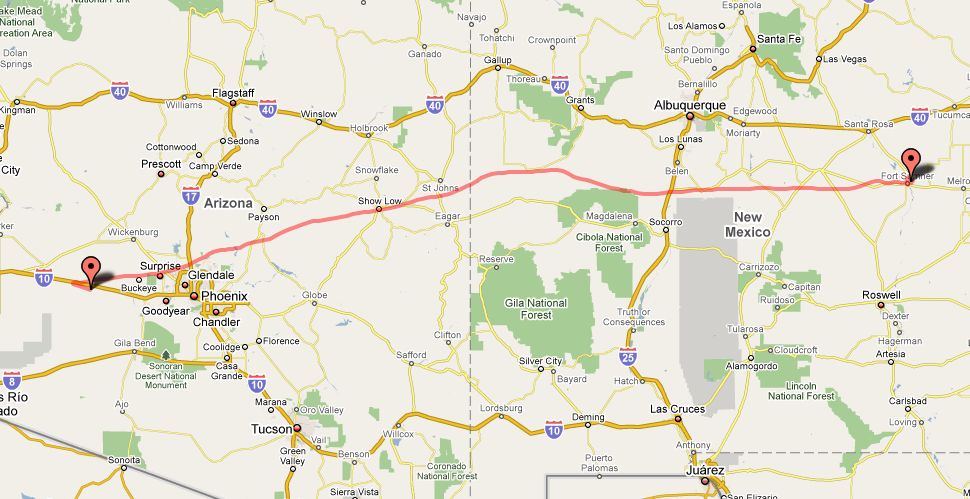
Balloon launched on: 9/11/2009 at 8:48 mst
Launch site: Scientific Flight Balloon Facility, Fort Sumner, (NM), US
Balloon launched by: Columbia Scientific Balloon Facility (CSBF)
Balloon manufacturer/size/composition: Zero Pressure Balloon Raven - 11.820.000 cuft
Balloon serial number: W11.82-1E-37
Flight identification number: 600N
End of flight (L for landing time, W for last contact, otherwise termination time): 9/11/2009 at 22:46 mst
Balloon flight duration (F: time at float only, otherwise total flight time in d:days / h:hours or m:minutes - ): 13 h
Landing site: 93 km W of Phoenix, Arizona, US
The balloon was launched by dynamic method with assistance from launch vehicle (Big Bill) at 14:48 utc on September 11.
After a nominal ascent phase it reached the float altitude of 124.000 ft starting a westward stable route entering in Arizona 14 hours later.
The mission was terminated at 5:35 utc on September 12. The payload landed with minor damage 45 nautic miles west of Phoenix, Arizona.
This fourth flight of the platform included the following experiments:
A module devoted to perform several experiments a new data storage unit that will require minimal communication relying on discrete power up and down commands to be used on future CubeSat satellites; a solar cell experiment to test the spectral response of an ultra-thin stimulator in an Indium Tin Oxide-Si cell; and finally a thermal experiment designed to calculate the atmospheric effect of at least two thermally dissimilar materials measuring their contraction and expansion (Hawk Institute for Space Sciences / UMES)
A test bed of multi-mission satellite subsystems for future proposed Nanosat class spacecraft This experiment will provide calibration of sun photometers which are critically dependent on the extraterrestrial (ET) constant, i.e. the intensity of sunlight at the top of the atmosphere using an array of detectors and, measurement of the downwelling infrared radiation caused by the major greenhouse gases aside from water vapor using an IR thermometer. Also a position/attitude determination module will be included (Embry-Riddle Aeronautical University).
Flying InfraRed Experiment for Lunar Investigation (FIREFLI) - a look-down infrared camera as a proof-of-concept for a potential lunar mission experiment. The camera will capture images of thermally radiating surfaces throughout the mission. Due to the differing thermal properties of materials, the resulting images can be used to determine the composition of the surface (Virginia Tech).
University of Maryland Advanced Balloon Communications Experiment (UMD/ABC) - A lightweight, low power prototype downlink telemetry/uplink commanding system suitable for use in students balloon flights. During past missions the system demostrated reliable up and down communication for a range in excess of 400 miles using less than one watt of onboard power.
Cajun Probe I - A prototype instrument package incorporating temperature, humidity, pressure, and background radiation sensors as well an accelerometer, and GPS that provides benchmark data for the development of a future probe capable of being injected with a rocket or balloon at high altitude into a hurricane. Such a probe could provide a more complete vertical storm profile than is possible with current lower altitude probes. (University of Louisiana - Lafayette)
Detection of ozone and nitrogen oxides in the stratosphere using nanocrystalline sensor arrays - The goal of the experiment is to test in flight a series of miniature ozone and nitrogen oxide gas sensors and to determine the profile of these gases as a function of altitude. The experiment was developed as a collaboration between students of the University of North Florida (UNF) and the University of North Dakota (UND). UNF developed the nanocrystalline ITO thin film gas sensor array while UND developed the balloon payload electronics and mechanical systems necessary for the readout, telemetry and control of these sensors.
Distant Aerial Cosmic Radiation Acquisition Package - An experiment to measure and classify cosmic radiation energy in the Earth's atmosphere at various altitudes and various sunlight exposures over a specified flight time. The main components of the package include a scintillation detector, comprised of a Sodium Iodide (NaI) crystal and a photomultiplier tube, a voltage divider, and a multi-channel analyzer. These components are controlled via a single board computer (SBC) and throught an analog-to-digital conversion circuit the data obtained can be stored on a memory card (West Virginia University).
MRE II - Microwave Reception Experiment - a project that focuses on characterizing the microwave background at stratospheric altitude in the frequency band between 45 and 75GHz including the understanding of possible interferences in higher frequency bands. A secondary goal of this experiment is testing the system for a possible future cryogenic HASP mission designed specifically to detect the Cosmological Microwave Background (CMB). MRE II will use the latest passive microwave reception technology on the smallest scale ever attempted to capture and analyze these waves.
High Altitude Particle Detection and Collection Experiment - An instrument designed to determine the concentration, size distribution and chemical composition of particles in the upper atmosphere. It uses a passive collection system which is opened only during float to capture particles that fall on the collection surface along with a laser particle detector employed to measure particle size and number density in real time throughout the flight (Montana State University).
Balloon Observatory for Wavelength and Spectral Emission Readings (BOWSER) - designed to study the feasibility of balloon-borne astronomical observatories. The payload includes multiple camera equipped telescopes for capturing stellar field images to assess 'seeing' conditions at balloon altitudes during day and night periods as well as multiple spectral emission sensors to assess the optimum wavelengths for such observations. In addition, the payload is equipped with a magnetometer, an accelerometer and a gyroscope to investigate the balloon platform stability and orientation (University of Colorado).
Second Look Intelligent Calibration Cameras System (SLICC) - An experiment designed to compare CCD and CMOS digital imagers in a near space environment for future use in the determination of the attitude of a spacecraft (Texas A&M University).
COSMOCAM - a web camera developed by Rocket Science, Inc. designed to bring live views of the balloon launch and flight from on-board the payload to students, classroom and the general public. The video camera head, mounted on a vertical stanchion, includes a 26º optical zoom with full pan and tilt control available over the web. The downlinked streaming video is retransmitted over the internet for general viewing. CosmoCam was particularly useful for the project as it allows student teams to visually inspect and monitor their payload during flight.
External references
- HASP website Louisiana Space Consortium
- BOWSER project page at Colorado Space Grant Consortium website
- BOWSER team web log at Colorado Space Grant Consortium website
- BOWSER website Colorado Space Grant Consortium
- HASP Team Prepares for Launch Colorado Space Grant Consortium
- Hawk-HASP team web site Hawk Institute for Space Science
- Scientific balloon flies across Valley infoirmation on HASP appeared in Arizona's TV Channel 12 website
- Some preliminary results on HASP 2009 experiments at National Space Grant Meeting 2009 (in PDF format)
3947If you consider this website interesting or useful, you can help me to keep it up and running with a small donation to cover the operational costs. Just the equivalent of the price of a cup of coffee helps a lot.

